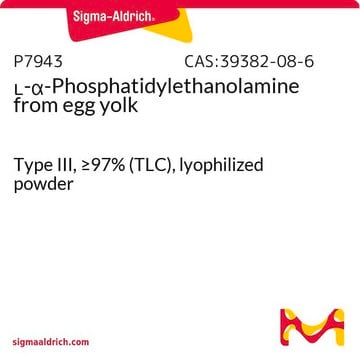P2772
L-α-Phosphatidylcholine
egg yolk, Type XI-E, 100 mg/mL in chloroform, ≥99%, solution
Synonym(s):
1,2-Diacyl-sn-glycero-3-phosphocholine, 3-sn-Phosphatidylcholine, L-α-Lecithin, Azolectin, PC
About This Item
Recommended Products
biological source
egg yolk
Quality Level
type
Type XI-E
Assay
≥99%
form
solution
concentration
100 mg/mL in chloroform
functional group
phospholipid
lipid type
phosphoglycerides
storage temp.
−20°C
InChI
1S/C42H80NO8P/c1-6-8-10-12-14-16-18-20-21-23-25-27-29-31-33-35-42(45)51-40(39-50-52(46,47)49-37-36-43(3,4)5)38-48-41(44)34-32-30-28-26-24-22-19-17-15-13-11-9-7-2/h14,16,20-21,40H,6-13,15,17-19,22-39H2,1-5H3/b16-14-,21-20-/t40-/m1/s1
InChI key
JLPULHDHAOZNQI-ZTIMHPMXSA-N
Looking for similar products? Visit Product Comparison Guide
Related Categories
Application
<li><strong>Fabrication of Microalgae Oil Vesicles for Drug Delivery Applications:</strong> This study highlights the use of L-a-Phosphatidylcholine in creating microalgae oil vesicles, showing promise for encapsulating and delivering hydrophobic drugs effectively (Lin YC et al., 2024).</li>
<li><strong>Terpenes-Modified Lipid Nanosystems for Temozolomide, Improving Cytotoxicity against Glioblastoma Human Cancer Cells In Vitro:</strong> L-a-Phosphatidylcholine is employed to formulate terpene-modified lipid nanosystems, enhancing the solubility and bioactivity of temozolomide for glioblastoma treatment (Pashirova TN et al., 2023).</li>
<li><strong>Mitochondria-Targeted Lipid Nanoparticles Loaded with Rotenone as a New Approach for the Treatment of Oncological Diseases:</strong> Utilizing L-a-Phosphatidylcholine, this research developed mitochondria-targeted lipid nanoparticles, potentially offering a novel strategy for cancer therapy (Vasileva L et al., 2023).</li>
</ul>
Biochem/physiol Actions
Preparation Note
Signal Word
Danger
Hazard Statements
Precautionary Statements
Hazard Classifications
Acute Tox. 3 Inhalation - Acute Tox. 4 Oral - Carc. 2 - Eye Irrit. 2 - Repr. 2 - Skin Irrit. 2 - STOT RE 1 Oral - STOT SE 3
Target Organs
Central nervous system, Liver,Kidney
Storage Class Code
6.1D - Non-combustible acute toxic Cat.3 / toxic hazardous materials or hazardous materials causing chronic effects
WGK
WGK 3
Flash Point(F)
Not applicable
Flash Point(C)
Not applicable
Personal Protective Equipment
Certificates of Analysis (COA)
Search for Certificates of Analysis (COA) by entering the products Lot/Batch Number. Lot and Batch Numbers can be found on a product’s label following the words ‘Lot’ or ‘Batch’.
Already Own This Product?
Find documentation for the products that you have recently purchased in the Document Library.
Customers Also Viewed
Our team of scientists has experience in all areas of research including Life Science, Material Science, Chemical Synthesis, Chromatography, Analytical and many others.
Contact Technical Service







